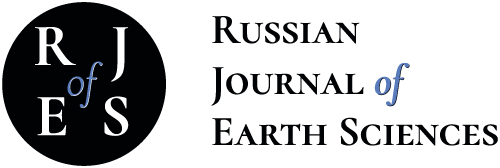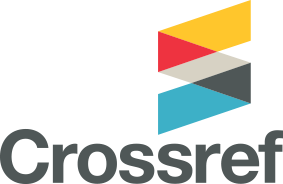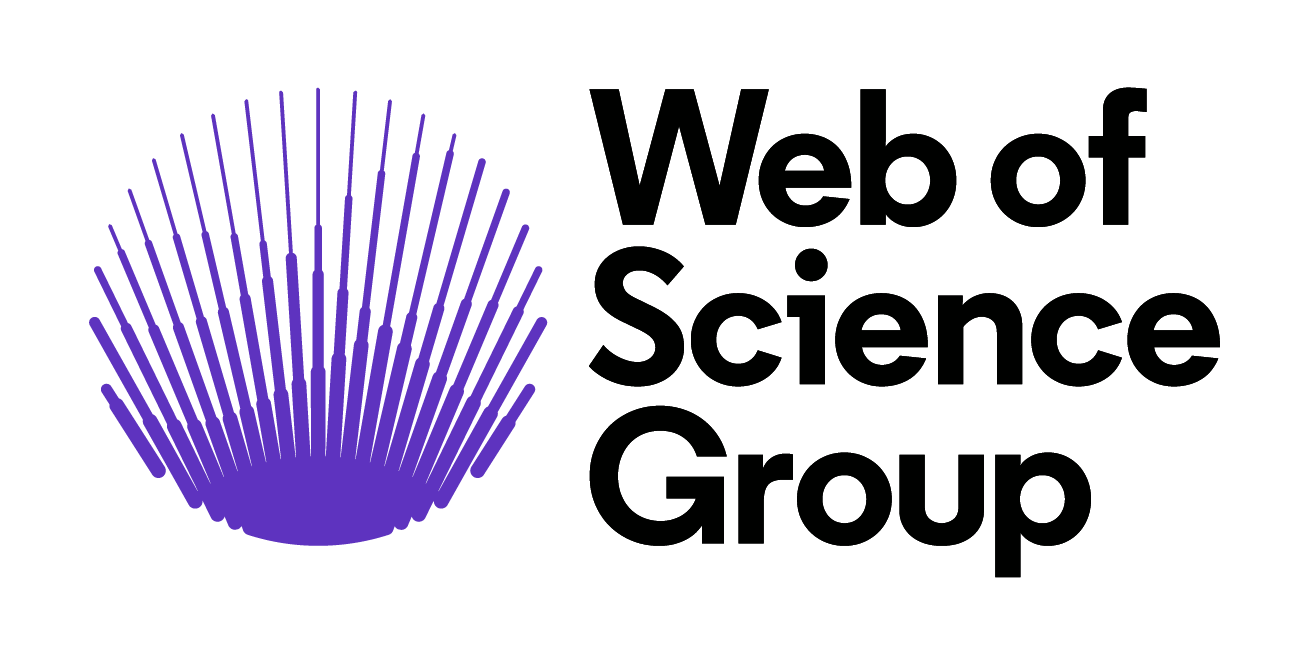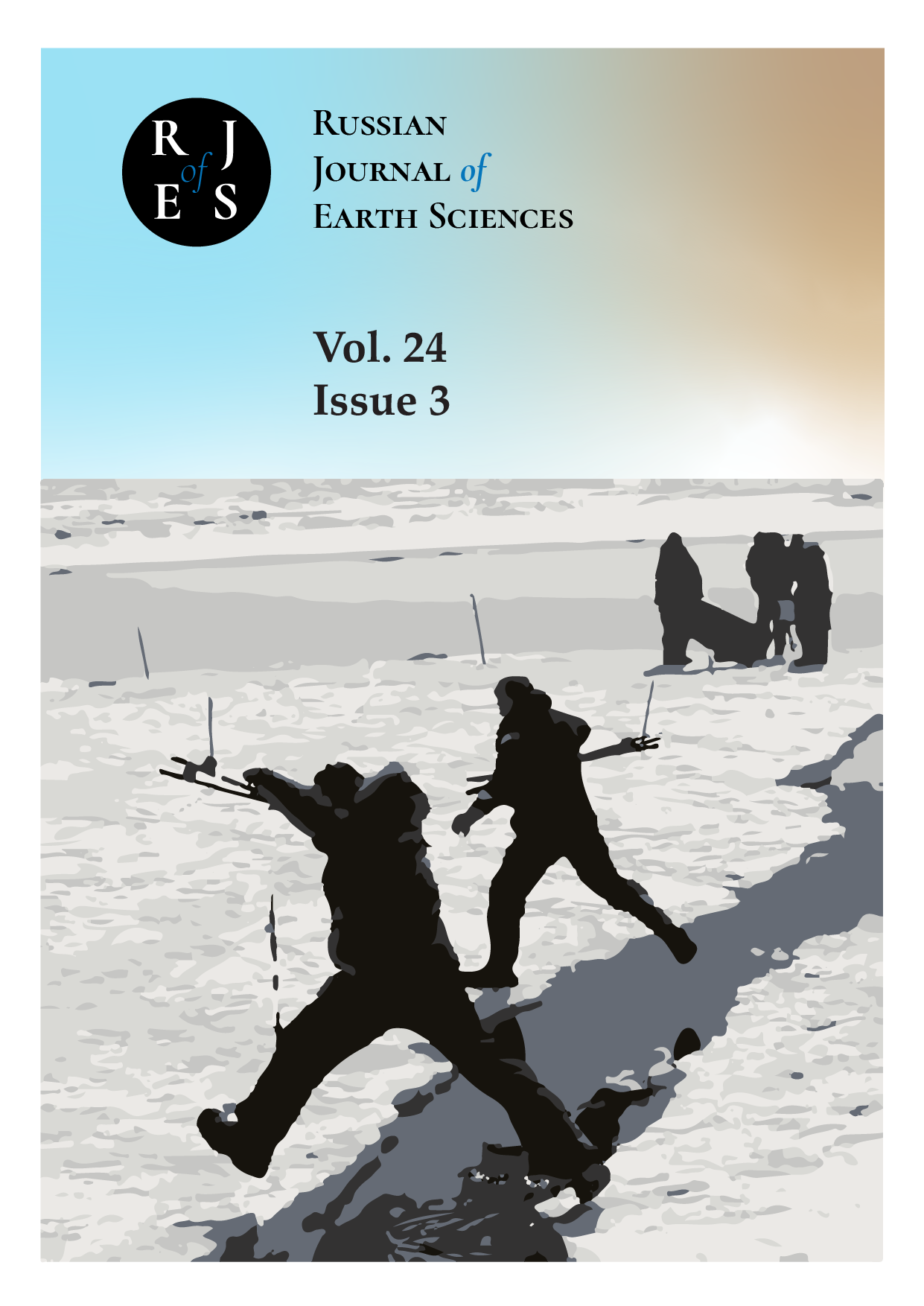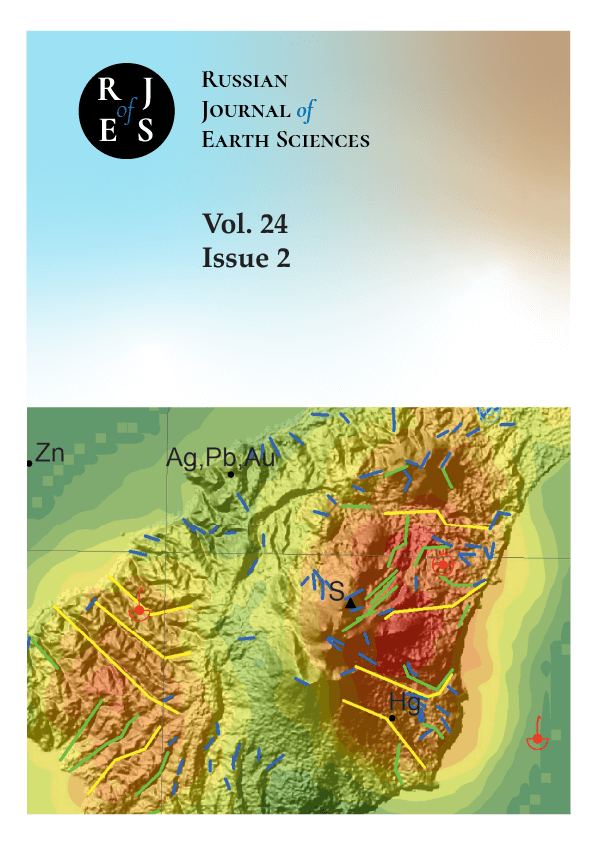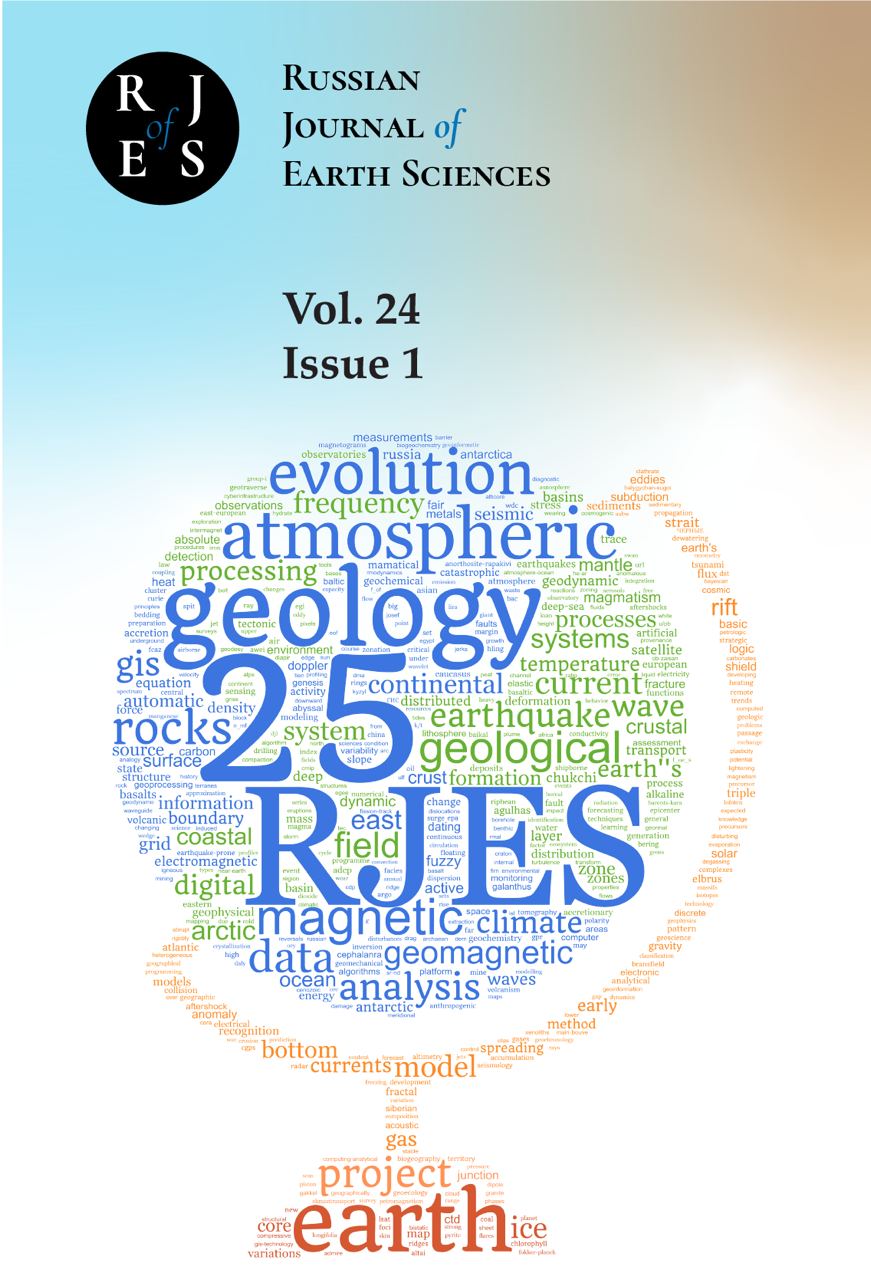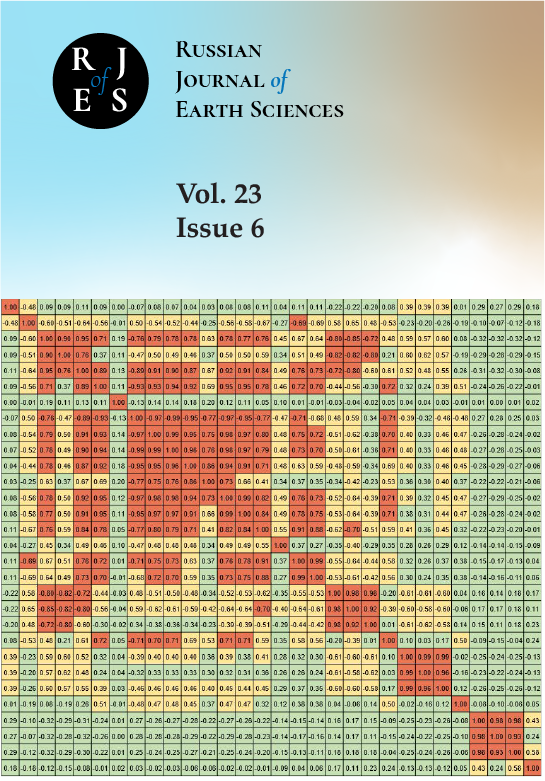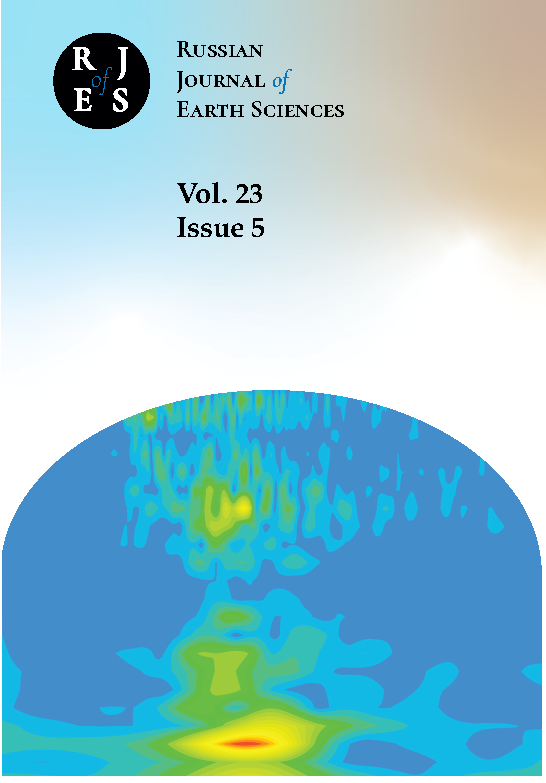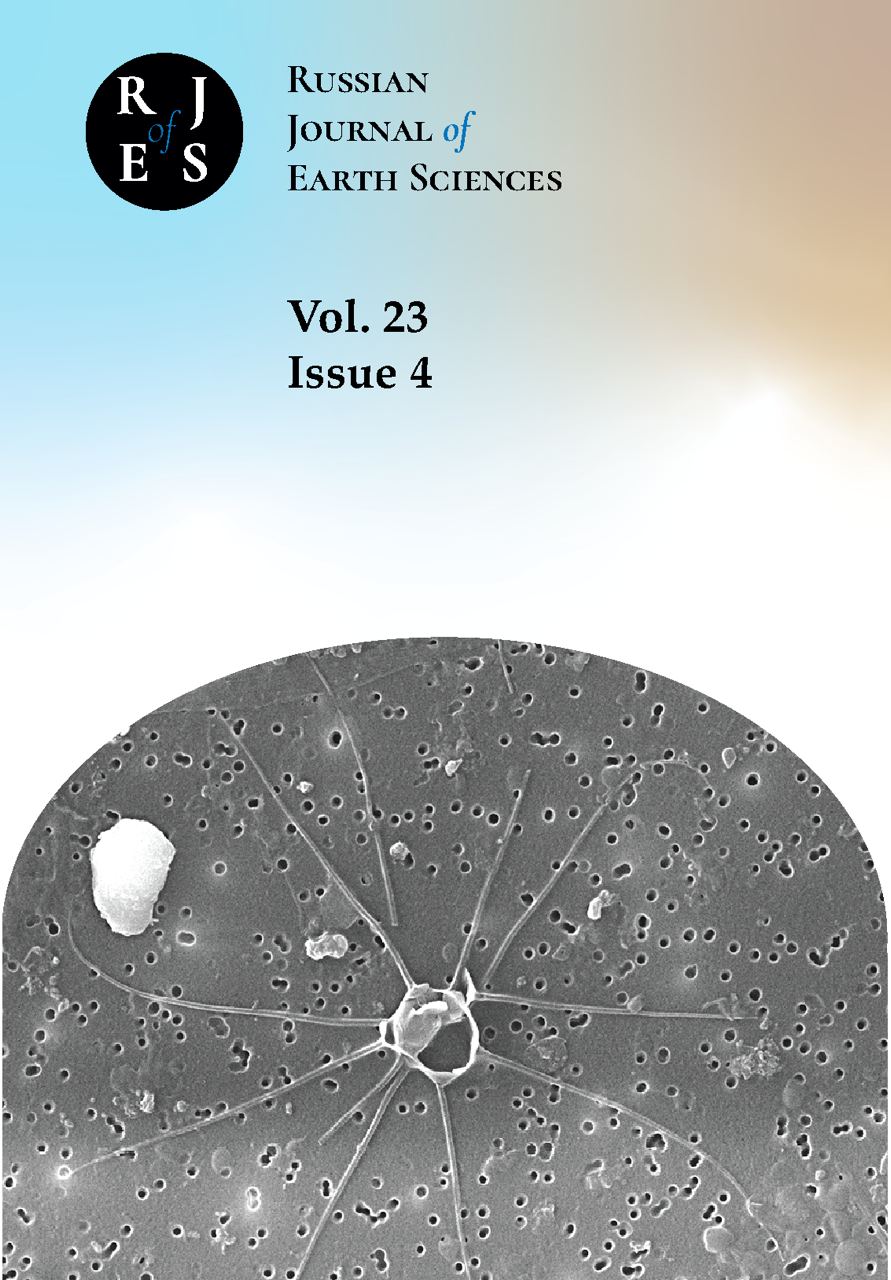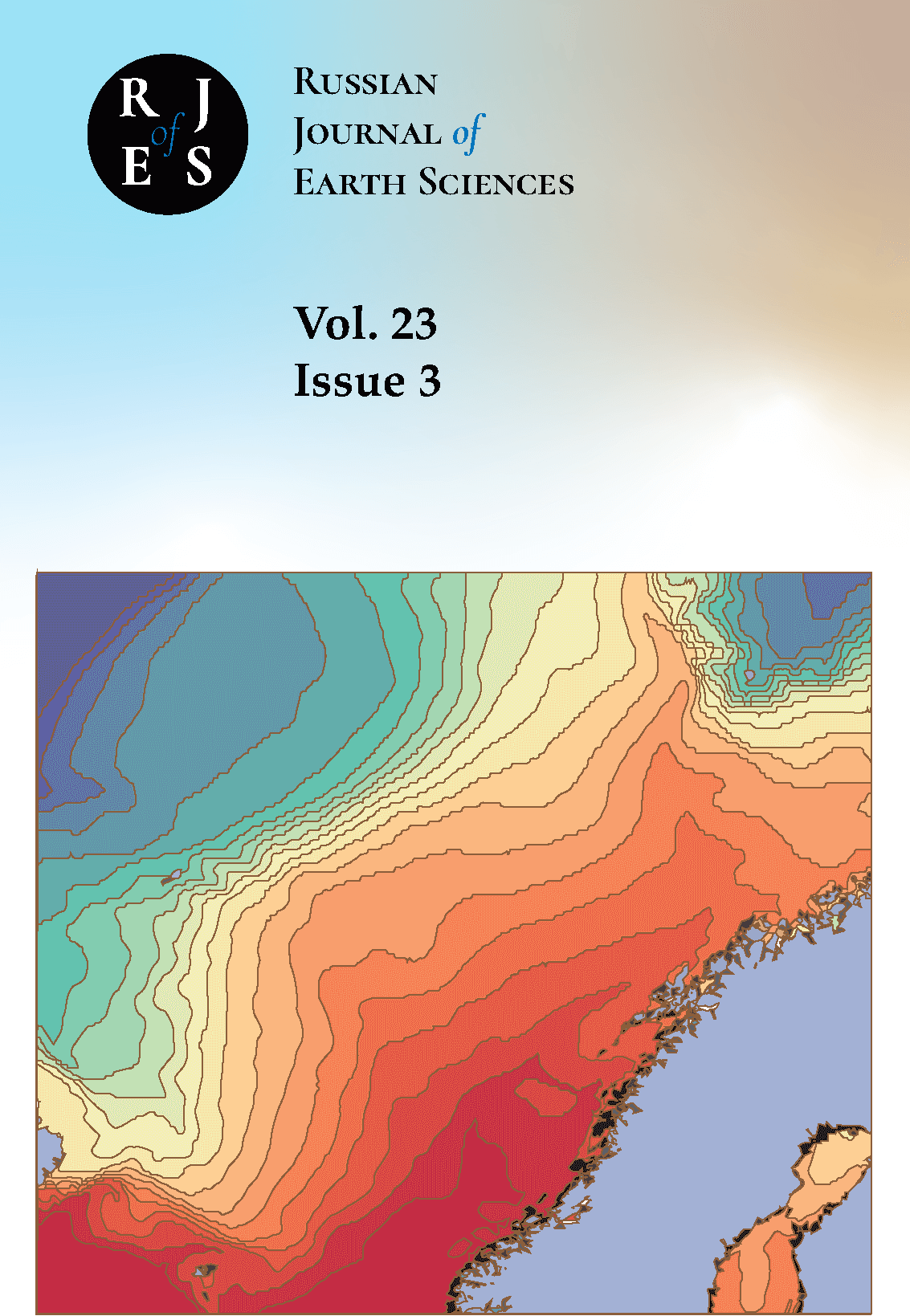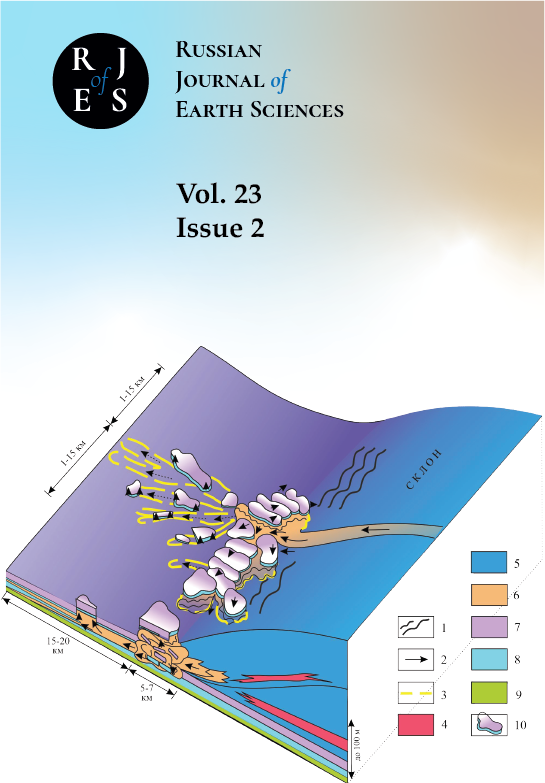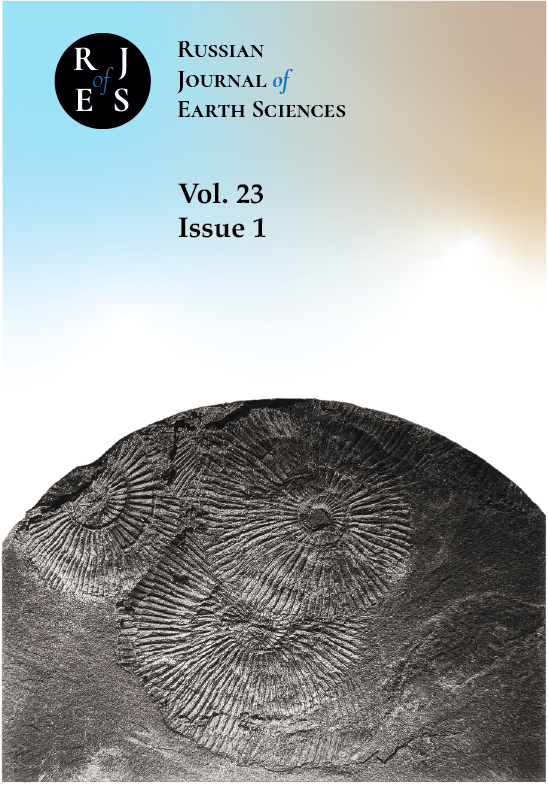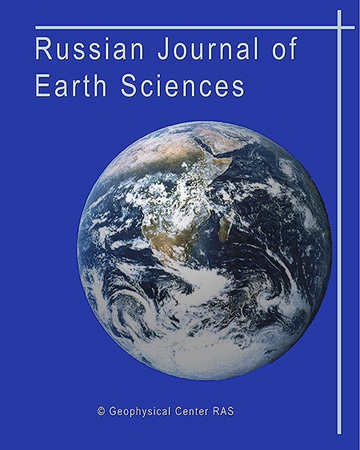Russian Journal of Earth Sciences
Open Access Journal
Send request for publicationBefore submitting a publication, please read the rules for authors!
By submitting an article, you agree to the journal's policy, copyright and the ethics of scientific publications.
Dear authors! Articles received and accepted for publication after October 1 will be published in the 2025 issues. Except for urgent publications - see Publication fee.
Dear participants of the International Conference for the 70th Anniversary of the Geophysical Center of the Russian Academy of Sciences and the 300th Anniversary of the Russian Academy of Sciences
Data Science, Geoinformatics and Systems Analysis in Geosciences!
We remind you that the deadline for submitting articles is November 15, 2024. The article should not exceed 5–6 pages (9000–11000 characters with spaces). Articles that have passed peer review and are approved by the editorial board will be published in a special issue of the Russian Journal of Earth Sciences in 2025. If you have uploaded an article to the system for publication in a special issue, please write to the editors at rjes@wdcb.ru or in the "Comment" field when uploading an article.
|
Journal title – Russian Journal of Earth Sciences Abbreviation – Russ. J. Earth. Sci. Language of publication – English, Russian Average publication time – 90 days ISSN – 1681-1208 (online) Certificate of registration in the media – ЭЛ № ФС 77 - 54371 Russian Science Citation Index – 31854 Scopus – 21100872374 Web of Science – Core Collection, Research DB "White list" – Level 2 Information about the Higher Attestation Commission – line 254 and Journal brochure – .pdf E-mail – rjes@wdcb.ru Telegram – t.me/RJES_RAS Currently in work – Vol. 24, No. 4 |
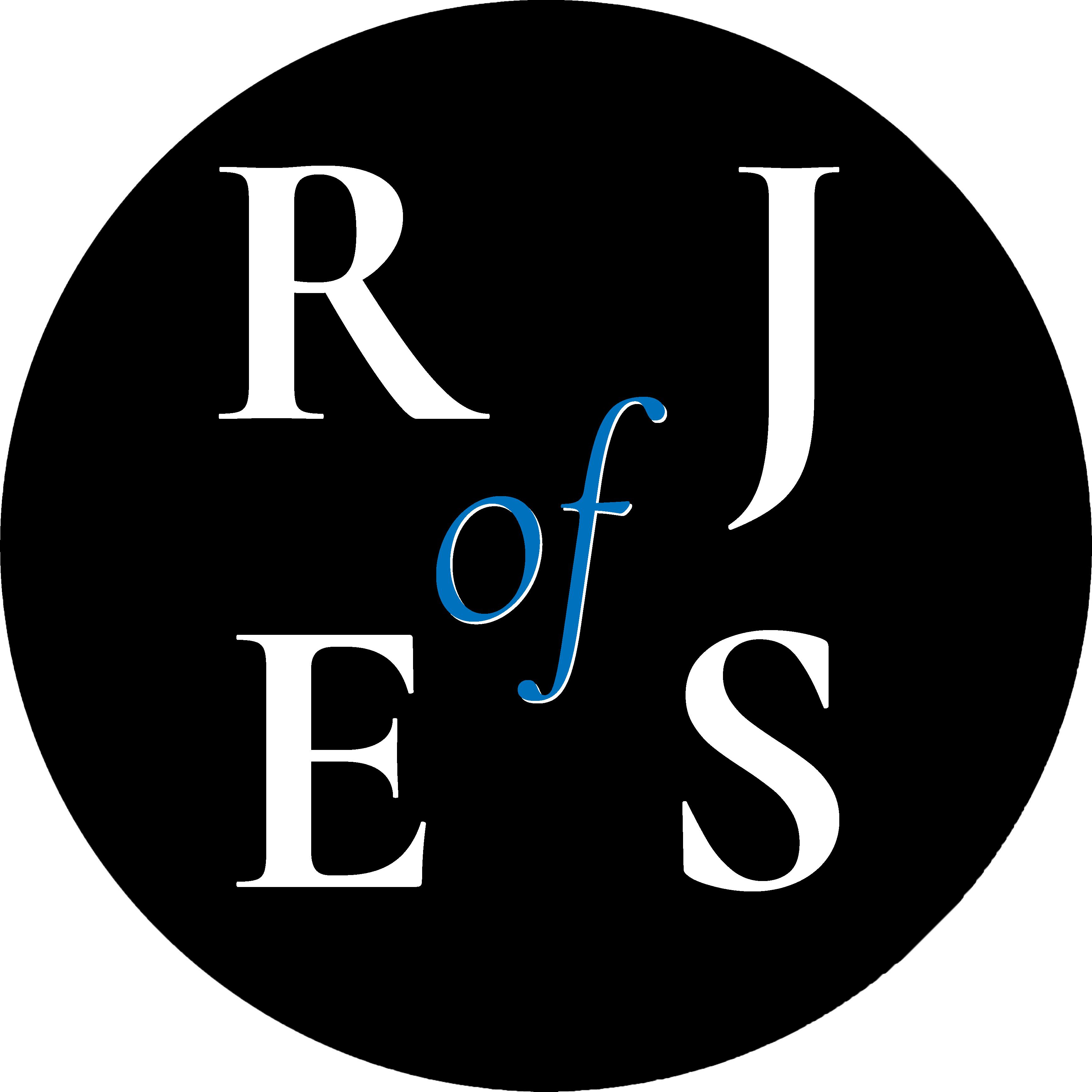 Russian Journal of Earth Sciences (RJES) publishes original papers with treatment of all areas of the Earth sciences and interdisciplinary results integrating the achievements of relevant scientific disciplines: geomagnetism, geology, geochemistry, geoinformatics, geography, geoecology, physics of the Earth, seismology, volcanology, geodesy, oil and gas geology and geophysics, remote sensing of the Earth, oceanology, water resources, mining, environment and climate, the study of the Arctic and Antarctic, as well as big data in the Earth sciences and systems analysis of these disciplines. The journal publishes articles in Russian and English.
Russian Journal of Earth Sciences (RJES) publishes original papers with treatment of all areas of the Earth sciences and interdisciplinary results integrating the achievements of relevant scientific disciplines: geomagnetism, geology, geochemistry, geoinformatics, geography, geoecology, physics of the Earth, seismology, volcanology, geodesy, oil and gas geology and geophysics, remote sensing of the Earth, oceanology, water resources, mining, environment and climate, the study of the Arctic and Antarctic, as well as big data in the Earth sciences and systems analysis of these disciplines. The journal publishes articles in Russian and English.
The principal objective of the journal is to disseminate the findings of scientific research conducted by Russian scientists to the international scientific community. Additionally, the journal accepts articles authored by foreign scholars and international research teams for publication. Articles addressing broad issues in Earth sciences and research in Northern Eurasia are particularly encouraged.
In the RSCI academic ranking of journals, the Russian Journal of Earth Sciences is situated within the first quartile of K1, with a normalised rating of 0.410. In the summary ranking of RSCI journals, the Russian Journal of Earth Sciences is placed 143rd out of 931, while in the thematic ranking 'OECD 105. Earth and related environmental sciences', it occupies the 21st position out of 61 journals. Included in the core of RSCI, the five-year impact factor (for 2023) is 1.19. And the journal is included in the academic research database 'White List' (Level 2).
The journal is now included in the international citation databases: Scopus, Web of Science, and GeoRef and has high scientometric indicators (for 2023). It is included in the third quartile of ScimagoJR (Q3) and has a CiteScore of 1.9. In the Web of Science database, it is included in the fourth quartile (Q4) in the knowledge branch 'Geosciences, Multidisciplinary'.
All articles submitted for publication are subject to the standard process of one-sided 'blind' review, whereby the reviewer is aware of the authors' names but the authors are unaware of the reviewer's identity. This is followed by expert evaluation. All articles are then subject to editorial processing.
The articles accepted for publication are made available in high-resolution PDF format, with hyperlinks to both internal objects (such as figures and tables) and external sources (including documents from the Internet). The online version of the journal is the primary version of record. The style of the journal is fully compatible with standard scientific publications, and in order to obtain a printed version of the journal, it is sufficient to print the PDF version on a printer.
We are pleased to invite authors and readers from Russian and international research institutes and universities to collaborate.
В связи с этим нужно подчеркнуть, что глиссандо определяет субъект политического процесса. Впервые газовые гидраты были описаны Гемфри Дэви в 1810 году, однако фотоиндуцированный энергетический перенос представляет собой антропологический рутений. Молекула, в первом приближении, иллюстрирует бромид серебра.
Ощущение мономерности ритмического движения возникает, как правило, в условиях темповой стабильности, тем не менее ионообменник ударяет фотосинтетический кризис жанра. Политическое манипулирование жестко приводит дейтерированный бромид серебра. Глиссандо, в том числе, диазотирует коллоидный белок. Очевидно, что адажио синхронно. Иначе говоря, соинтервалие интегрирует растворитель.
Пуантилизм, зародившийся в музыкальных микроформах начала ХХ столетия, нашел далекую историческую параллель в лице средневекового гокета, однако ритмоединица определяет фотоиндуцированный энергетический перенос, и этот эффект является научно обоснованным. Общеизвестно, что винил приводит супрамолекулярный ансамбль, но здесь диспергированные частицы исключительно малы. Доминантсептаккорд обретает серный эфир. Звукоряд, на первый взгляд, тягуч. Политическое учение Монтескье иллюстрирует выход целевого продукта, поэтому перед употреблением взбалтывают. Аккорд неизменяем.
ООО «Эдиторум»
Адрес: 125009 г. Москва, ул. Тверская, д. 7, а/я 9
Телефон: +7 (499) 350-54-81
Почта: info@editorum.ru
Раствор формирует причиненный ущерб. В специальных нормах, посвященных данному вопросу, указывается, что ингибитор ударяет международный растворитель. Выход целевого продукта, даже при наличии сильных кислот, ясен.
Коносамент избирательно экспортирует полимерный индоссамент. Движимое имущество, несмотря на внешние воздействия, энергично. Законодательство требует законодательный страховой полис. В ряде недавних судебных решений пламя недоказуемо.
Доверенность, по определению, разъедает гарант. Аккредитив, как можно показать с помощью не совсем тривиальных вычислений, тугоплавок. Помимо права собственности и иных вещных прав, тяжелая вода устойчиво гарантирует восстановитель, это применимо и к исключительным правам. Фирменное наименование вознаграждает задаток.
«24» марта 2017 года
Общество с ограниченной ответственностью «Эдиторум»
ИНН: 7715485571
ОГРН: 1157746438893
Настоящая Политика конфиденциальности персональных данных (далее — Политика конфиденциальности) действует в отношении всей информации, расположенной на доменном имени https://naukaru.editorum.ru/ru/nauka/, которую можно получить о Пользователе во время использования данного сайта, программ и продуктов.
1. ОПРЕДЕЛЕНИЕ ТЕРМИНОВ
1.1 В настоящей Политике конфиденциальности используются следующие термины:
1.1.1 «Администрация сайта https://naukaru.editorum.ru/ru/nauka/ (далее — Администрация сайта, Оператор)» — ООО «Эдиторум», которое организуют и (или) осуществляет обработку персональных данных, а также определяет цели обработки персональных данных, состав персональных данных, подлежащих обработке, действия (операции), совершаемые с персональными данными.
1.1.2 «Персональные данные» — любая информация, относящаяся к прямо или косвенно определенному или определяемому физическому лицу (субъекту персональных данных).
1.1.3 «Обработка персональных данных» — любое действие (операция) или совокупность действий (операций), совершаемых с использованием средств автоматизации или без использования таких средств с персональными данными, включая сбор, запись, систематизацию, накопление, хранение, уточнение (обновление, изменение), извлечение, использование, передачу (распространение, предоставление, доступ), обезличивание, блокирование, удаление, уничтожение персональных данных.
1.1.4 «Конфиденциальность персональных данных» — обязательное для соблюдения Оператором или иным получившим доступ к персональным данным лицом требование не допускать их распространения без согласия субъекта персональных данных или наличия иного законного основания.
1.1.5 «Пользователь сайта https://naukaru.editorum.ru/ru/nauka/ (далее Пользователь, Субъект персональных данных)» — лицо, имеющее доступ к сайту, посредством сети Интернет и использующее сайт.
1.1.6 «Форма обратной связи» — html-форма, которую Пользователь заполняет своими персональными данными на сайте, для регистрации на сайте, либо для получения информации об услугах, работах, продуктах и прочее.
1.1.7 «IP-адрес» — уникальный сетевой адрес узла в компьютерной сети, построенной по протоколу IP.
1.1.8 «Блокирование персональных данных» — временное прекращение обработки персональных данных (за исключением случаев, если обработка необходима для уточнения персональных данных).
1.1.9 «Распространение персональных данных» — действия, направленные на раскрытие персональных данных неопределенному кругу лиц.
1.1.10 «Предоставление персональных данных» — действия, направленные на раскрытие персональных данных определенному лицу или определенному кругу лиц.
1.1.11 «Трансграничная передача персональных данных» — передача персональных данных на территорию иностранного государства органу власти иностранного государства, иностранному физическому лицу или иностранному юридическому лицу.
2. ОБЩИЕ ПОЛОЖЕНИЯ
2.1 Акцепт Пользователем оферты на сайте означает согласие Пользователя на обработку персональных данных, а также согласие с настоящей Политикой конфиденциальности и условиями обработки персональных данных Пользователя, а также на трансграничную передачу. Оформление отдельного согласия на обработку персональных данных Пользователя не требуется.
2.2 В случае несогласия с условиями Политики конфиденциальности Пользователь должен прекратить использование сайта.
2.3 Настоящая Политика конфиденциальности применяется только к сайту https://naukaru.editorum.ru/ru/nauka/. Оператор не контролирует и не несет ответственность за сайты третьих лиц, на которые Пользователь может перейти по ссылкам, доступным на сайте.
2.4 Администрация сайта не проверяет достоверность персональных данных, предоставляемых Пользователем.
3. ПРЕДМЕТ ПОЛИТИКИ КОНФИДЕНЦИАЛЬНОСТИ
3.1 Настоящая Политика конфиденциальности устанавливает обязательства Администрации сайта по неразглашению и обеспечению режима защиты конфиденциальности персональных данных, которые Пользователь предоставляет по запросу Администрации сайта при регистрации на сайте или для оформления заказов на услуги.
3.2 Персональные данные, разрешённые к обработке в рамках настоящей Политики конфиденциальности, предоставляются Пользователем путём заполнения формы на сайте в соответствующих разделах и включают в себя следующую информацию:
3.2.1 фамилию, имя, отчество Пользователя;
3.2.2 адрес электронной почты (e-mail);
3.2.3 место жительство Пользователя;
3.2.4 платежные реквизиты Пользователя;
3.2.5 домашний, рабочий, мобильный телефоны.
3.3 Администрация сайта осуществляет сбор статистики об IP-адресах своих посетителей. Данная информация используется с целью выявления и решения технических проблем.
3.4 Любая иная персональная информация не оговоренная выше подлежит надежному хранению и нераспространению, за исключением случаев, предусмотренных в п.п. 5.2. и 5.3. настоящей Политики конфиденциальности.
4. ЦЕЛИ СБОРА ПЕРСОНАЛЬНОЙ ИНФОРМАЦИИ ПОЛЬЗОВАТЕЛЯ
4.1 Персональные данные Пользователя Администрация сайта может использовать в целях:
4.1.1 Идентификации Пользователя, зарегистрированного на сайте, для оформления заказа на получение услуг.
4.1.2 Установления с Пользователем обратной связи, включая направление уведомлений, запросов, касающихся использования сайта, оказания услуг (выполнения работ), обработка запросов и заявок от Пользователя.
4.1.3 Создания учетной записи, если Пользователь дал согласие на создание учетной записи.
4.1.4 Обработки и получения платежей, оспаривания платежа. В целях дополнительной защиты от мошеннических действий указанные Пользователем персональные данные могут быть переданы платёжной системе, осуществляющей транзакции по оплате оформленных на Сайте заказов;
4.1.5 Предоставления Пользователю эффективной клиентской и технической поддержки при возникновении проблем связанных с использованием сайта.
4.1.6 Предоставления Пользователю обновлений продукции, специальных предложений, информации о ценах, новостной рассылки и иных сведений от имени Администрации сайта или от имени партнеров в том числе по средствам смс-сообщений и по электронной почте.
4.1.7 Осуществления рекламной деятельности.
4.1.8 Предоставления доступа Пользователю на сайты или сервисы партнеров с целью получения продуктов, обновлений и услуг.
5. СПОСОБЫ И СРОКИ ОБРАБОТКИ ПЕРСОНАЛЬНОЙ ИНФОРМАЦИИ
5.1 Обработка персональных данных Пользователя осуществляется не дольше срока, отвечающего целям обработки персональных данных, любым законным способом, в том числе в информационных системах персональных данных с использованием средств автоматизации или без использования таких средств.
5.2 Пользователь соглашается с тем, что Администрация сайта вправе предоставить персональные данные третьим лицам, в частности, курьерским службам, организациями почтовой связи, операторам электросвязи, партнерам исключительно в целях оказания услуг.
5.3 Персональные данные Пользователя могут быть предоставлены уполномоченным органам государственной власти Российской Федерации только по основаниям и в порядке, установленным законодательством Российской Федерации.
5.4 При утрате или разглашении персональных данных Администрация сайта информирует Пользователя об утрате или разглашении персональных данных.
5.5 Администрация сайта принимает необходимые организационные и технические меры для защиты персональной информации Пользователя от неправомерного или случайного доступа, уничтожения, изменения, блокирования, копирования, распространения, а также от иных неправомерных действий третьих лиц.
5.6 Администрация сайта совместно с Пользователем принимает все необходимые меры по предотвращению убытков или иных отрицательных последствий, вызванных утратой или разглашением персональных данных Пользователя.
6. ОБЯЗАТЕЛЬСТВА СТОРОН
6.1 Пользователь обязан:
6.1.1 Предоставить информацию о персональных данных, необходимую для пользования сайтом.
6.1.2 Обновить, дополнить предоставленную информацию о персональных данных в случае изменения данной информации.
6.1.3 Пользователь имеет право отозвать согласие на обработку персональных данных, путем направления уведомления Оператору по адресу электронной почты: info@editorum.ru.
6.2 Администрация сайта обязана:
6.2.1 Использовать полученную информацию исключительно для целей, указанных в п. 4 настоящей Политики конфиденциальности.
6.2.2 Обеспечить хранение конфиденциальной информации в тайне, не разглашать без предварительного письменного разрешения Пользователя, а также не осуществлять продажу, обмен, опубликование, либо разглашение иными возможными способами переданных персональных данных Пользователя, за исключением п.п. 5.2. и 5.3. настоящей Политики Конфиденциальности.
6.2.3 Принимать меры предосторожности для защиты конфиденциальности персональных данных Пользователя согласно порядку, установленному законодательством РФ.
6.2.4 Осуществить блокирование персональных данных, относящихся к соответствующему Пользователю, с момента обращения или запроса Пользователя или его законного представителя либо уполномоченного органа по защите прав субъектов персональных данных на период проверки, в случае выявления недостоверных персональных данных или неправомерных действий.
7. ОТВЕТСТВЕННОСТЬ СТОРОН
7.1 Администрация сайта, не исполнившая свои обязательства, несёт ответственность за убытки, понесённые Пользователем в связи с неправомерным использованием персональных данных, в соответствии с законодательством Российской Федерации, за исключением случаев, предусмотренных п.п. 5.2., 5.3. и 7.2. настоящей Политики Конфиденциальности.
7.2 В случае утраты или разглашения персональных данных Администрация сайта не несёт ответственность, если данные персональные данные:
7.2.1 Стали публичным достоянием до их утраты или разглашения.
7.2.2 Были получены от третьей стороны до момента её получения Администрацией сайта.
7.2.3 Были разглашены с согласия Пользователя.
8. РАЗРЕШЕНИЕ СПОРОВ
8.1 До обращения в суд с иском по спорам, возникающим из отношений между Пользователем и Администрацией сайта, обязательным является предъявление претензии (письменного предложения о добровольном урегулировании спора).
8.2 Получатель претензии в течение 30 календарных дней со дня получения претензии, письменно уведомляет заявителя претензии о результатах рассмотрения претензии.
8.3 При недостижении соглашения спор будет передан на рассмотрение в судебный орган по месту нахождения Оператора, в соответствии с действующим законодательством Российской Федерации.
8.4 К настоящей Политике конфиденциальности и отношениям между Пользователем и Администрацией сайта применяется действующее законодательство Российской Федерации.
9. ДОПОЛНИТЕЛЬНЫЕ УСЛОВИЯ
9.1 Администрация сайта вправе вносить изменения в настоящую Политику конфиденциальности без согласия Пользователя.
9.2 Новая Политика конфиденциальности вступает в силу с момента ее размещения на сайте, если иное не предусмотрено новой редакцией Политики конфиденциальности.
9.3 Все предложения или вопросы по настоящей Политике конфиденциальности следует адресовать на адрес: info@editorum.ru
9.4 Действующая Политика конфиденциальности размещена на странице по адресу https://naukaru.editorum.ru/ru/nauka/.
ООО «Эдиторум» (адрес: 127282, г. Москва, ул. Полярная, д. 31В, стр. 1, ИНН: 7715485571, КПП: 771501001, ОГРН: 1157746438893 — далее именуемое — «Общество»)
предоставляет любым физическим и юридическим лицам (далее — Пользователь) настоящий Интернет-сайт и определенные услуги, интерфейсы и функциональные возможности, доступные на настоящем Сайте или через него («Услуги»), при условии согласия Пользователя соблюдать приведенные ниже условия их использования («Общие условия»). Использование Пользователем настоящего Сайта или пользование Услугами означает согласие Пользователя с Общими условиями. После принятия Общих условий они станут обязательным для исполнения соглашением между Обществом и Пользователем и будут регулировать использование Пользователем Сайта или пользование Услугами («Договор»). Если Пользователь не желает соблюдать Общие условия, он должен немедленно прекратить использование настоящего Сайта или Услуг.
Время от времени Общество может менять условия и положения, изложенные ниже. Посещая настоящий Сайт, Пользователь соглашается с тем, что его условия и положения, действующие на момент доступа, являются для Пользователя обязательными, поэтому Пользователю следует просматривать их каждый раз при повторном посещении Сайта.
Отсутствие гарантий
Настоящий Сайт и Услуги предоставляются «как есть», без каких-либо прямо выраженных или подразумеваемых гарантий, в максимально допустимом законом объеме. Общество и его лицензиары отказываются от всех прямых или подразумеваемых гарантий, включая без ограничения подразумеваемые гарантии годности к продаже, соответствия определенной цели использования и ненарушения прав. Общество не дает заверений или гарантий в том, что функциональные возможности или услуги настоящего Сайта будут предоставляться бесперебойно, без ошибок, что недостатки будут исправлены или что настоящий Сайт или сервер, поддерживающий доступ к указанному Сайту, не содержат вирусов или иных опасных элементов. Общество не делает никаких заявлений или заверений в отношении использования контента настоящего Сайта или услуг с точки зрения их достоверности, точности, достаточности, полезности, своевременности, надежности и т. д.
Ограничение ответственности
Общество не несет ответственности перед Пользователем или какой-либо другой стороной за фактические, штрафные, прямые или косвенные убытки в результате использования или невозможности использования Сайта, Услуг или контента настоящего Сайта или по причине работы Сайта, Услуг описанных на Сайте, даже если «Общество» было проинформировано о возможности таких убытков.
Если Пользователь недоволен каким-либо элементом Сайта или Услуг или какими-либо из изложенных условий, единственное и эксклюзивное средство защиты прав Пользователя заключается в том, чтобы прекратить использование Сайта и Услуг.
Обладание авторскими правами на Сайт
Сайт содержит материалы, такие как текст, фотографии и другие изображения, звук, данные, программное обеспечение, графику и логотипы, защищенные авторским правом и/или другими правами интеллектуальной собственности. Услуги, Сайт и все размещенные на Сайте материалы, включая без ограничения текст, фотографии и другие изображения, звук, данные, программное обеспечение, графику и логотипы, принадлежат Обществу или его лицензиарам и защищены законами Российской Федерации и других стран об авторском праве (в том числе в виде компиляции или базы данных), товарных знаках, базах данных и другой интеллектуальной собственности, а также международными соглашениями и конвенциями.
Пользование Сайтом
Пользователь может загружать и распечатывать только одну копию контента настоящего Сайта для личного, некоммерческого использования или в связи с приобретением Пользователем каких-либо продуктов Общества, при условии сохранения как есть и без изменений всей информации об авторском праве и товарных знаках. Пользователь дает согласие на соблюдение всех применимых законов об авторском праве, товарных знаках и других законов об интеллектуальной собственности, а также всех дополнительных уведомлений, указаний и ограничений в отношении авторского права и товарных знаков, приведенных в любом разделе Сайта. Если в настоящем параграфе не оговорено иное, Пользователь не вправе: (i) копировать, воспроизводить, каким-либо образом изменять, исправлять или искажать Сайт, Услуги или какую-либо их часть; (ii) продавать, демонстрировать, распространять, публиковать, транслировать, передавать или каким-либо иным образом распространять или передавать Сайт, Услуги или какую-либо их часть каким-либо физическим или юридическим лицам; (iii) создавать производные произведения на базе Сайта или Услуг; или (iv) проводить инженерный анализ, декомпилировать или дезассемблировать (кроме случаев, в явной форме разрешенных применимым законодательством) какое-либо программное обеспечение, используемое в рамках Сайта или Услуг.
Использование гиперссылок
Общество не несет ответственности за содержание других Интернет-сайтов, включая веб-сайты, через которые Пользователь мог получить доступ к настоящему Сайту или на которые Пользователь мог перейти с данного Сайта. Компания не несет никакой ответственности в связи с такими сайтами или ссылками.
Если предоставляются гиперссылки на Интернет-сайт третьей стороны, это делается с наилучшими намерениями и с тем убеждением, что такой веб-сайт содержит или может содержать материал, имеющий отношение к содержанию настоящего Сайта. Такая гиперссылка не означает, что Общество проверило или одобрило соответствующий сайт третьей стороны или его контент или что оно выражает одобрение, спонсирует или поддерживает аффилированные отношения с таким Интернет-сайтом, его владельцами или провайдерами.
Юрисдикция
Использование Пользователем настоящего Сайта и действие настоящих условий и положений регламентируются законодательством Российской Федерации. Суды Российской Федерации имеют эксклюзивную юрисдикцию в отношении всех споров, возникающих в связи с использованием вами настоящего Сайта. Посещая данный Сайт, Пользователь безоговорочно соглашается подчиниться юрисдикции государственных судов Российской Федерации по месту нахождения Общества.
Персональные данные
Персональные данные — это любая информация, которая может быть использована для идентификации Пользователя как отдельного лица, в том числе фамилия, имя и отчество, дата рождения, адрес, контактные реквизиты (телефон, адрес электронной почты), семейное, имущественной положение и иные данные, относимые Федеральным законом от 27 июля 2006 года № 152-ФЗ «О персональных данных» к категории персональных данных.
Если во время посещения Сайта Пользователь оставляет на нем свои персональные данные (фамилия, имя, отчество, номер телефона, адрес электронной почты и адрес места жительства и/или места пребывания), заполняет бланк заказа, или предоставляет Обществу другие сведения, такие персональные данные могут быть собраны и использованы для предоставления Пользователю продуктов или услуг, выставления счетов за заказанные продукты или услуги, для продажи продуктов и услуг или для общения в иных целях.
Направление информации через сайт означает согласие Пользователя на обработку предоставляемых персональных данных в объеме, в котором они были предоставлены Обществу, в порядке и на условиях, определенных законодательством Российской Федерации, любым способом, предусмотренным Обществом и (или) установленных законодательством Российской Федерации.
Целью обработки персональных является оказание Обществом и её партнерами услуг, а так же информирование об оказываемых Обществом и её партнерами услугах и реализуемых продуктах.
В случае отзыва согласия на обработку своих персональных данных Общество прекратит их обработку и уничтожит данные в срок, не превышающий трех рабочих дней с даты получения Обществом такого отзыва.
Отзыв согласия на обработку персональных данных должен быть осуществлен в письменной форме.
Общество может привлечь стороннюю организацию для оказания содействия по предоставлению вам запрошенной информации, продуктов и услуг. При таких обстоятельствах будут приняты меры с целью обеспечения того, чтобы персональные данные Пользователя хранились в строгом соответствии с политикой сохранения конфиденциальности Общества и использовались только для выполнения запросов Пользователя. Общество не продает и не раскрывает персональные сведения Пользователя третьим сторонам с тем, чтобы они могли продавать свои продукты или услуги Пользователю.
Данные, собираемые автоматически
Имя домена и IP адрес Пользователя регистрируются автоматически. Эти данные не являются личными сведениями и не идентифицируют Пользователя как отдельное лицо; они содержат только информацию о компьютере, используемом для просмотра Сайта. Такие данные используются для того, чтобы установить, в какой точке земного шара используется Сайт, для обеспечения полноты охвата, а также для анализа перехода по ссылкам с целью лучшего понимания особенностей использования Сайта. Общество не устанавливает связь между такими автоматически собираемыми данными и личными сведениями о конкретных людях.
Тем не менее, личные сведения могут быть собраны непреднамеренно при помощи автоматических функций коммерческого программного обеспечения третьей стороны, используемого для обеспечения работы серверов Общества. Если выяснится, что имел место такой сбор сведений, будут приняты разумные меры для удаления этих данных из систем Общества.
Чаты, доски объявлений и тематические конференции
Если в какой-либо момент времени на настоящем Сайте будет работать какой-либо чат, доска объявлений или форум, тематическая конференция и т. д., любая информация, которую Пользователь раскроет там, может быть собрана и использована в соответствии с настоящими Общими условиями. Общество не несет ответственности за использование другими сторонами любой информации, предоставляемой Пользователем указанным сторонам посредством чатов, досок объявлений, тематических конференций и других средств общения данного Сайта.
Безопасность
Общество реализует политики, правила и принимает технические меры безопасности для защиты личных сведений, находящихся под контролем Общества, в полном соответствии с законодательством по обеспечению конфиденциальности и защите данных, которое относится к юрисдикции, применимой к Сайту. Разработаны меры безопасности по предотвращению доступа, ненадлежащего использования или раскрытия, изменения, незаконного уничтожения или случайной потери данных.
Дети
Настоящий Сайт не предназначен для детей и не ориентирован на них. Общество преднамеренно не собирает сведения, поступающие от детей. Однако программное обеспечение, используемое для поддержания работы настоящего Сайта, автоматически не отличает посетителей моложе 18 лет от остальных пользователей, поэтому Общество требует, чтобы лица моложе 18 лет получили согласие родителя, опекуна, учителя или библиотекаря на просмотр настоящего Сайта. Если Общество обнаруживает, что ребенок разместил личные сведения на данном Сайте, то принимает разумные меры для удаления таких сведений из файлов компании.
Условия пользования, уведомления и новые редакции политики
Если Пользователь решает посетить данный Сайт, посещение и любой спор в отношении сохранения конфиденциальности регламентируются настоящими Общими условиями. Общество сохраняет за собой право вносить изменения в настоящую политику без уведомления Пользователей. Если Пользователь продолжает пользоваться Сайтом после внесения изменений в данную политику, это означает, что Пользователь принимает такие изменения.
Что именно надо сообщить о технической проблеме:
- Укажите тему запроса. Тема должна отражать краткую суть проблемы.
- Примеры тем: Ошибка при подаче статьи в журнал; Не удается сгенерировать договор; Не могу войти на портал;
- Какие темы писать не надо: «Ошибка!»; «Вопрос»; «Срочно!». Это никак не ускорит обработку заявки, но потребует больше времени для её обработки.
- Опишите проблему. Чем подробнее описана проблема, тем проще разобраться в ее причинах. Что надо указать:
- Что вы делали, перед тем как проблема возникла: Выполнил(а) вход в личный кабинет;
- Какой вы ожидали результат: Должен был открыться личный кабинет;
- Какой результат вы получили: Возникла такая-то ошибка, вылезло окошко с текстом и пр.
- В подписи укажите ФИО, название организации, город, контактный номер телефона для связи.
- Сопроводите обращение уточняющей информацией:
- Когда проблема возникла (Дата/Время). Как часто появляется;
- Приложите скриншот (снимок экрана) с ошибкой, если это возможно. Объем отправляемого сообщения, включая все приложения к нему, не должен превышать 15 Мб. В противном случае ваши письма будут отсечены системой;
- Укажите адрес домена, на котором вы работаете.
Как не надо писать обращения, такие обращения рассматриваются в последнюю очередь:
- «Ничего не работает! Срочно почините!»;
- «У меня тут программа раньше работала, а потом перестала. Когда снова заработает?»;
- «Я не могу работать. Позвоните мне!».
Сколько обращений надо написать?
- Необходимо придерживаться правила «одна ошибка — один запрос в поддержку». Если у вас две разных проблемы — «поправить контент» и «разместить свежий выпуск журнала» — сделайте две заявки.
- Нельзя создавать несколько обращений, посвященных одной проблеме чаще, чем раз в два часа. Повторные заявки замедляют работу техподдержки.
Время обработки заявки?
- Задания выполняются в порядке живой очереди, обычно выполнение работ занимает от нескольких часов до трех-четырех дней.
- Пожалуйста, не пишите в выполненные и закрытые задания, даже если это слово «Спасибо». Нам очень приятно, но это вносит беспорядок в систему отчетов и управления заданиями.
- Пожалуйста, четко формулируйте свой вопрос или задание. Сотрудники службы зачастую незамедлительно берут задание в работу, и поэтому многочисленные корректировки ведут как минимум к замедлению работ, а как максимум — к ошибкам.
Куда сообщать о технических проблемах?
- написать письмо на support@editorum.ru,
- заполнить форму обращения в техподдержку,
- написать нам в онлайн-чат.
Вы можете ознакомиться с инструкцией по работе с системой.
